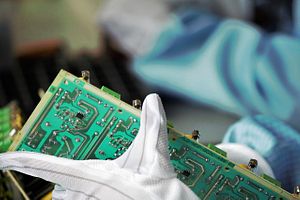The Diplomat author Mercy Kuo regularly engages subject-matter experts, policy practitioners, and strategic thinkers across the globe for their diverse insights into U.S. Asia policy. This conversation with Dr. David Yoffie – Max and Doris Starr Professor of International Business at Harvard Business School and author of numerous publications on strategy and technology – is the 280th in “The Trans-Pacific View Insight Series.”
Evaluate the effectiveness of TSMC and Samsung in meeting global demand for chips.
The impact of the pandemic led to a surprising surge in demand for semiconductors, which no one anticipated. The result has been long queues at TSMC and Samsung on filling orders. Moreover, it takes roughly two years to build and qualify a new semiconductor fab. As a result, it was impossible for any foundry to ramp new production quickly enough to satisfy demand. The effectiveness of TSMC and Samsung to meet demand is disappointing for the world, but largely beyond their short-term control.
Explain the impact of China-U.S. tech competition on TSMC and Samsung’s market strategies.
Samsung is not directly in the line of fire between the United States and China on semiconductors. However, TSMC is central to the conversation. Since TSMC controls over 60 percent of foundry capacity worldwide, American companies and American policymakers are very concerned over the concentration of so much critical capacity in a location which could be threatened by geopolitical forces beyond their control.
How do geopolitical tensions in the Taiwan Strait factor into TSMC’s corporate risk management?
If tensions escalate between the U.S. and China, or much more seriously between China and Taiwan, any disruption in supply at TSMC could cripple some of the most important U.S. tech companies, especially Apple, Nvidia, AMD, and Qualcomm. As a result, TSMC (and to a lesser degree, Samsung) have to explore spreading their capacity decision to more locations around the world, especially to the U.S. and Europe. TSMC and Samsung need to reassure their global customers that tensions with China will not disrupt supply, and they have contingency plans to manage any worst-case scenarios.
Identify strategic risks for companies if chip shortages persist long term.
The strategic risks vary dramatically by company and industry. For some industries, such as autos, which rely on older generations of technology, the primary problem is a slowdown in production and lost sales. Most companies will be relatively equally impacted. For tech companies such as AMD and Nvidia, they are more dependent on leading-edge capacity, mostly from TSMC. Failure to supply could lead to loss in market share and a reduction in their lead over Intel. For Apple, it depends on how TSMC allocates capacity. Today, TSMC appears to give Apple priority because it such a large and important customer. If Apple retains its position at the top of the queue, it may not be severely impacted, even if the shortages persist for a longer time.
How should U.S. policymakers and business leaders mitigate risks to U.S. companies reliant on chip production?
The primary focus for U.S. policymakers and business leaders is creating sufficient capacity within the U.S. The Biden administration would like to provide about $50 billion in aid to the American semiconductor industry to facilitate more rapid building of new capacity to meet demand. But there are only two domestic manufacturers in the U.S.: Intel and Micron. Today, the vast majority of their production is used for their own chips. Intel has announced plans to create a foundry that would compete with TSMC and Samsung, but Intel remains at least a full generation (and probably more than a full generation) behind TSMC. The U.S. government should also explore incentives to accelerate TSMC and Samsung building more capacity within the U.S. While this would take two to three years, it would help mitigate the long-term risks related to geopolitical problems in Asia.

































